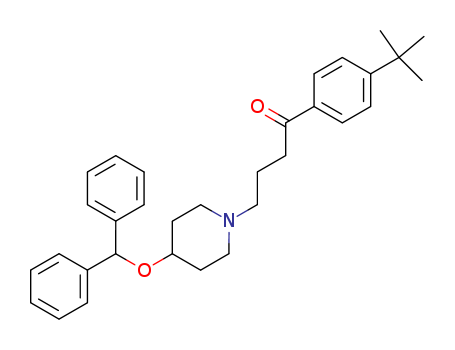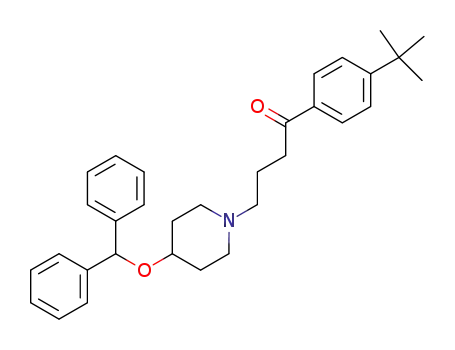
90729-43-4
- Product Name:Ebastine
- Molecular Formula:C32H39NO2
- Purity:99%
- Molecular Weight:469.667
Product Details;
CasNo: 90729-43-4
Molecular Formula: C32H39NO2
Appearance: White to off-white powder
Wholesale Quality Factory Supply Ebastine 90729-43-4 Efficient Shipping
- Molecular Formula:C32H39NO2
- Molecular Weight:469.667
- Appearance/Colour:White to off-white powder
- Vapor Pressure:3.47E-14mmHg at 25°C
- Melting Point:80-82 °C
- Refractive Index:1.59
- Boiling Point:596.3 °C at 760 mmHg
- PKA:8.19±0.10(Predicted)
- Flash Point:314.5 °C
- PSA:29.54000
- Density:1.09 g/cm3
- LogP:7.15550
Ebastine(Cas 90729-43-4) Usage
|
Description |
Ebastine is metabolised by cytochrome P450 3A (CYP3A4) to carebastine. It is used to treat allergic rhinitis and chronic idiopathic urticaria. Ebastine belongs to an effective second generation histamine H1 receptor antagonist. One important property of it is that it doesn’t penetrate the blood brain barrier. Therefore, it is capable of blocking the H1 receptor in peripheral tissue without having some specific side effects such as sedation and drowsiness. Ebastine is mainly applied for the treatment of allergic rhinitis, pruritus as well as acting as an alternative drug in Decongestant. Upon entering into the human body, it can subject to the action of hepatic cytochrome P450 3A4 to be converted to an active carboxylic acid metabolite, carebastine. The later one is the major active form in vivo. Under certain range, it can inhibit T cell proliferation and the production of Th2-type pro-inflammatory cytokines through macrophages. Ebastine generally has a high safety property without causing cognitive/psychomotor impairment and sedation, like placebo. However, it can cause side effects such as inflammation of the air-cavities around nose, sore throat, indigestion, nausea, headache, and abdominal pain. |
|
Chemical Properties |
White to Off-White Powder |
|
Originator |
Almirall (Spain) |
|
Uses |
Ebastine is a second-generation H1 receptor antagonist that is indicated mainly for allergic rhinitis and chronic idiopathic urticaria. It is available in 10 and 20 mg tablets and as fast-dissolving tablets, as well as in pediatric syrup. It has a recommended flexible daily dose of 10 or 20 mg, depending on disease severity. |
|
Manufacturing Process |
(a) A mixture of 4-hydroxypiperidine (40.4 g; 0.4 moles), p-tert-butyl-ω- chlorobutyrophenone (105 g, 0.44 moles), sodium bicarbonate (67.2 g; 0.8 moles) and a crystal of potassium iodide in methyl isobutyl ketone (1 liter) was boiled under reflux for 24 hours. After cooling, the reaction mixture waswashed with water, dried (Na2SO4) and the solvent removed in vacuum. The residue was salified with the stoichiometric amount of fumaric acid in a mixture of acetone and ethanol to give 1-[3-(4-tert-butylbenzoyl)propyl]-4- hydroxypiperidine fumarate (148 g), melting point 163-165°C. This compound was converted into the free base, and 1-[3-(4-tert-butylbenzoyl)propyl]-4- hydroxypiperidine was obtained and recrystallized from a mixture of diethyl ether and petroleum ether (boiling point 50-70°C). 102 g were obtained (yield 84%), melting point 63-65°C.(b) A mixture of 1-[3-(tert-butylbenzoyl)propyl]-4-hydroxypiperidine (60.68 g; 0.2 moles) and sodium carbonate (42.4 g; 0.4 moles) in methyl isobutyl ketone (500 ml) was heated to the boiling point and a solution of diphenylmethyl bromide (49.42 g; 0.2 moles) in methyl isobutyl ketone (75 ml) was slowly added in 1.5 hours. The resulting mixture was boiled under reflux for another 12 hours, and then another solution of diphenylmethyl bromide (24.71 g; 0.1 moles) in methyl isobutyl ketone (50 ml) was added and the mixture boiled under reflux again for 12 hours. Another solution of diphenylmethyl bromide in the same quantity was added and after refluxing for 12 additional hours the reaction mixture was cooled, washed with water, dried (Na2SO4) and the solvent removed in vacuum.The residual oil was treated with the stoichiometric amount of fumaric acid in ethanol and 4-diphenylmethoxy-1-[3-(4-tert-butylbenzoyl)propyl]piperidine fumarate crystallized. After recrystallisation from ethanol the pure compound was obtained (88 g; yield 75%), melting point 197-198°C. |
|
Brand name |
Kestine (Rhone-Poulenc Rorer);Ebastel. |
|
Therapeutic Function |
Antihistaminic, Antiallergic, Calcium entry blocker |
|
Biochem/physiol Actions |
Ebastine is a non-sedating histamine H1 receptor antagonist, which inhibits allergen-induced bronchospasm in conscious guinea pigs. Unlike other compounds in this category, ebastine does not prolong the QT interval at up to five times the recommended therapeutic dose. |
InChI:InChI=1/C32H39NO2/c1-32(2,3)28-18-16-25(17-19-28)30(34)15-10-22-33-23-20-29(21-24-33)35-31(26-11-6-4-7-12-26)27-13-8-5-9-14-27/h4-9,11-14,16-19,29,31H,10,15,20-24H2,1-3H3
90729-43-4 Relevant articles
Comparison of Ebastine to Cetirizine in Seasonal Allergic Rhinitis in Adults
Pierre Gehanno MD *, Clothilde Bremard-Oury MD †, Philippe Zeisser MD †
, Annals of Allergy, Asthma & Immunology Volume 76, Issue 6, June 1996, Pages 507-512
Ebastine, 20 mg (n = 111), ebastine, 10 mg (116), and cetirizine, 10 mg (116), were all effective for improving nasal and ocular symptoms. There was, however, a general trend towards more rapid relief of symptoms with ebastine, 20 mg, and this reached statistical significance in some efficacy parameters after the first week of treatment.
PROCESS FOR THE PREPARATION OF 1-[4-(1,1-DIMETHYLETHYL)PHENYL]-4-[4-(DIPHENYLMETHOXY)-1-PIPERIDINYL]-1-BUTANONE AND ACID ADDITION SALTS THEREOF
-
Page/Page column 39-40, (2011/10/13)
The present invention describes processe...
Process for the preparation of 1-[4-(1,1-dimethylethyl)phenyl]-4-[4-(diphenylmethoxy)-1-piperidinyl]-1-butanone and acid addition salts thereof
-
Page/Page column 27, (2011/10/13)
The present invention describes processe...
90729-43-4 Process route
-

- 1338066-81-1
4-benzhydryloxypiperidine toluenesulfonate

-

- 43076-61-5
4'-tert-butyl-4-chlorobutyrophenone

-

- 90729-43-4
ebastine
| Conditions | Yield |
|---|---|
|
With potassium carbonate; In 4-methyl-2-pentanone; at 105 - 116 ℃; for 2.25h; Inert atmosphere;
|
55.27% |
|
With potassium carbonate; In 4-methyl-2-pentanone; at 105 - 116 ℃; Inert atmosphere;
|
55.27% |
-
![4-diphenylmethoxy-1-[3-[2-(4-tert-butylphenyl)-1,3-dioxolan-2-yl]propyl]piperidine](/upload/2023/8/e0113fcb-99ea-43a1-8a4f-c1414f8805ee.png)
-
4-diphenylmethoxy-1-[3-[2-(4-tert-butylphenyl)-1,3-dioxolan-2-yl]propyl]piperidine

-

- 90729-43-4
ebastine
| Conditions | Yield |
|---|---|
|
In hydrogenchloride; ethanol;
|
87.3% |
90729-43-4 Upstream products
-
58258-01-8

4-diphenylmethoxypiperidine
-
43076-61-5

4'-tert-butyl-4-chlorobutyrophenone
-
5382-16-1

4-HYDROXYPIPERIDINE
-
65214-86-0

4-(diphenylmethoxy)piperidine hydrochloride
90729-43-4 Downstream products
-
97928-21-7

1-(4-tert-butylphenyl)-4-(4-(benzhydryloxy)piperidin-1-yl)butan-1-ol
-
210686-41-2

Hydroxyebastine
-
1256285-71-8

ebastine N-oxide
-
1338066-82-2

1-[4-(1,1-dimethylethyl)phenyl]-4-[4-(diphenylmethoxy)-1-piperidinyl]-1-butanone tosylate
Relevant Products
-
1,2,3-Trifluoro-4-nitrobenzene
CAS:771-69-7
-
2,2-Dimethyl-1,3-dioxane-4,6-dione(meldrum's acid)
CAS:2033-24-1
-
Methazolamide
CAS:554-57-4









